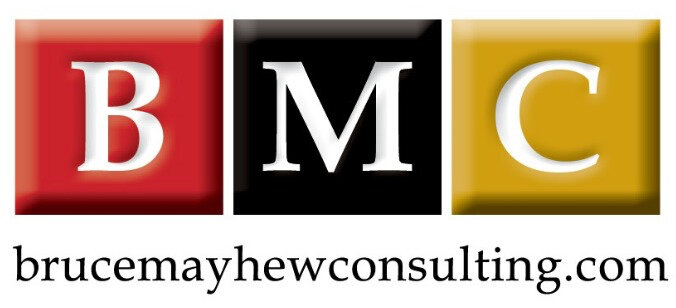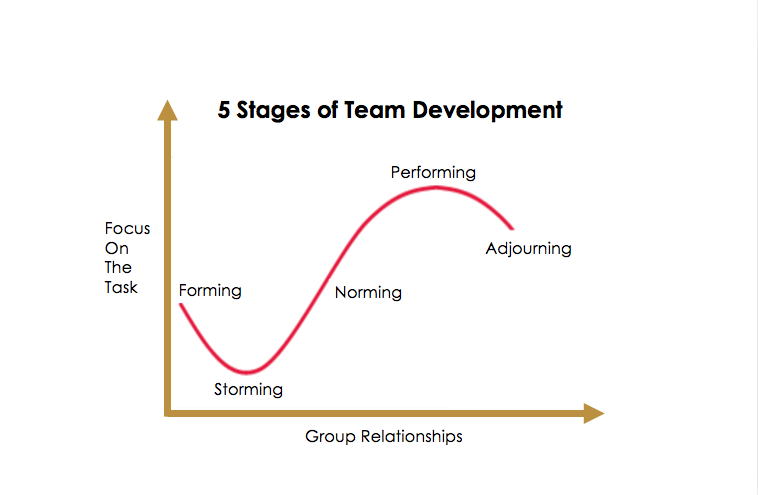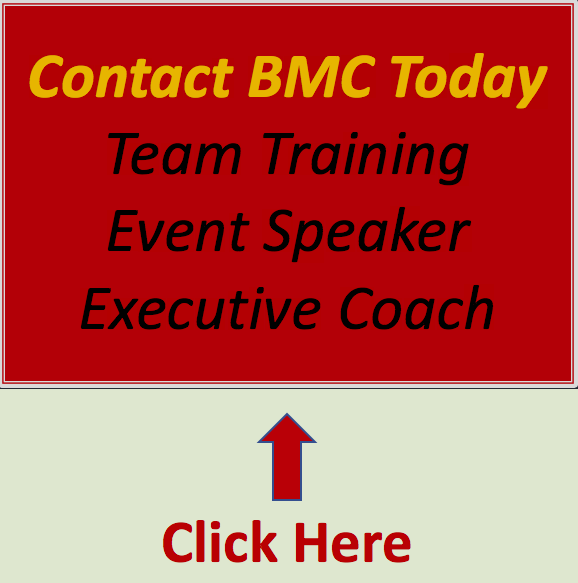5 Stages of Team Development
/How can you help your team succeed as a team and as individuals?
One important lesson I learned a long while ago is there are 5 stages of team development that every team passes through on its way to becoming an inspired high-performing team.
Cohesive teams don’t start out that way; they form over time and with hard work. Team members have to get to know each other for the team to reach peak effectiveness (stage #4). This is true in every situation including if you are:
A leader joining an existing team
Adding others to an existing team
Putting together a brand-new team
This knowledge has helped me be a better leader and executive coach. Now let me help you.
The 5 stages of team development i’ll be discussing with you were identified in 1965 by educational psychologist Bruce Tuckman. They are:
Forming
Storming
Norming
Performing
Adjourning
#1 Forming Stage
This stage is where team members meet each other, or where a new person is introduced to an existing team. Usually everyone is on their best behaviour until they find their place and learn about the other people. There is likely lots of uncertainty at this stage including the goals of the project and what the culture of the team will be like.
The leader’s role in this stage is to help the team get to know each other and explore the values, vision and goals associated with the task. As part of the team development, activities and group training should be designed to help everyone get to know each other and to begin setting a foundation of how the team will work and what the project goals are. Key training and agenda topics should include:
Mission (for Department / Company / Team)
Values
Project / Team Goals
Project / Team Timelines
Expectations of team, working groups and individuals in relation to communication methods, shared documents, feedback, evaluation / measurements of success and work styles (work from home as an example)
Leadership Support – who is the ‘Project Champion’
Individual responsibilities
In addition to the above, I recommend including an icebreaker and team building / orientation exercise during this stage. As the team begins to work through these details people usually become more comfortable with each other and their place in the group.
It is important to note that at this stage, the actual project goal is not moving forward. What is happening is the team is beginning to build a foundation of trust that will define the team culture and support progress in the future.
Fair warning, just because you select a group of high-performing individuals you may not get a high-performing team. High-performing individuals don’t always have the ability to work in a collaborative environment.
#2 Storming Stage
As team members learn more about each other they begin to experience behaviours they like and respect as well as behaviours that rub them the wrong way (as my dad would say). Conflict begins to emerge as the politeness of the Forming stage wears off and individual communication styles, personal goals and internal competition become clearer. As identified in the graph above, the team is even less effective at this stage; this is likely because the team members have lost trust, cohesiveness and purpose.
The Storming and Norming stages are usually where many teams fail because conflicts are not resolved and trust is not established. It is important to note that conflict is natural and all healthy teams – all the best teams experience conflict and have also have learned ways to resolve it.
The leader is there to support their team with coaching and training aimed at helping team members build a process for communication, trust and mutual respect. The leaders job is to reduce tension by helping their team / team members engage in difficult conversations and help individuals learn how to resolve challenges between themselves and understand that differences sometimes add not subtract from the team.
If i am coaching a client, the Storming stage is where I like to have a discussion about biases, because this is the stage that an individuals conscious and unconscious biases will be surfacing and they should watch out for this within their team.
Questions that the leader needs to help their team answer include:
What is considered acceptable behaviour?
How can we maximize our strengths?
What are our learning opportunities?
What are each other’s strengths?
Know that when someone else shines it helps the team, doesn’t take away from my spotlight.
Are agendas required for all meetings (please say yes to this)
What Project Management technique do we use… and do we all know how to use it?
How do we track performance?
The important thing for leaders is to help train their team – or get external training to make sure everyone knows how to manage conflict in a respectful and healthy way. Don’t try to avoid conflict. It is normal and can be healthy and be a good sign of a diverse team that have a variety of experiences and expertise.
Whatever you do, don’t overlook or diminish the importance of this step. No matter how experienced someone is, everyone has to be open to learning about themselves and each other at this stage.
#3 Norming Stage
What goes down must come up.
In the Norming stage team members begin to appreciate their team members’ strengths as well as find their own place. Trust, cohesiveness and purpose begin to emerge if the team is on the right track.
The team accepts a clear goal and aligns behind it. A leader’s job is to help each person take responsibility for tasks based on their own abilities and interests to grow while also ensuring they are meeting the expectations of other team members and the project / team goals. In short, everyone begins working together as a supportive team.
While trust and understanding are building, a team and/or its team members may fluctuate between Storming and Forming for some or all of its existence especially if new challenges or new team members are added.
If trust is not firmly established and a leader doesn’t clarify roles and expectations, then the team and project will likely fail. As stated earlier, the Storming and Norming stages are usually where many teams fail because conflicts are not resolved, and trust is not established.
#4 Performing Stage
It takes time to reach this stage, but this is the stage where the team becomes productive. If the leader takes on the role of coach and mentor with a desire to inspire their team and make sure they have the organizational support and training they need versus be their boss, it is likely the team will become a high-performing team.
At the Performing stage, everyone knows the Mission, Vision and Values as introduced in the Forming stage. In addition, they have learned what the Mission, Vision and Values mean which allows them to make strategically appropriate decisions without having to always get someone else’s opinion.
The team works together toward outcomes. And while disagreements may happen, challenges are met head-on and everyone works together to resolve them quickly – often by the team members alone. Collaboration remains a core strength towards the goal.
During the Preforming stage team members know who to go to for information, saving time and potential duplication. Also, quality increases with less waste on people’s time or resources. People perform well together, therefore, often feel a sense of contribution and intrinsic satisfaction / pride which further boosts engagement and productivity.
During a project a team may fall out of performing should new people be added to the team and/or if the project goals change (for example). These may move the team back to Forming, Storming and/or Norming until a new equilibrium is established.
Instead of being a referee or task master, leaders take on the strategic roll including:
Supporting the project with appropriate resources, talent and training
Supporting team members individual goals and performance
Inspiring and motivating employees and the team
Coordinating value added messaging… and lots of it
Managing project performance, budgets and timelines
When the team is working well, they will automatically adjust on a daily basis with little to no required ‘management’ from the leader.
#5 Adjourning Stage
Without surprise, the Adjourning stage is about saying goodbye, the project is over. Now, this may be seen as unfortunate, but if the process has been a productive one this can be a time of celebration. And, just because this project is over it does make time and resources available for the next opportunity and learning curve.
After Adjourning I would recommend the team and each individual take a moment to consider what they have learned about themselves and about specific skills. Strictly as a learning process (not to take away from the glory of their success), highly productive teams often reflect on the past project and ask, ‘If I could change how I did X, I would have…’ and then move on.
While team development is the main topic of this blog post, you may also be interested in a blog I wrote called ‘Why Trust Matters and How To Build Trust At Work’.
Conclusion:
The leader plays an important role through all stages mentoring and coaching team members through these stages.
For teams to be effective, team members must be able to work together and contribute to their shared goals. But this does not happen automatically: it develops as the team works together and learns together.
Remember, teams that fail usually fail at stage 2 and 3. The best thing a leader can do here is help their team understand the conflict they are experiencing and to grow from it. Don’t try to avoid conflict; it is normal and can be healthy.
Thank you for reading. If you have questions please let me know
Bruce
About Bruce and Bruce Mayhew Consulting.
Bruce is Corporate Trainer, Keynote Speaker and Executive Coach.
As a Corporate Trainer Bruce Mayhew (of BMC) specialize in customized Time Management Training, Email Etiquette Training, Leadership & New Leadership Development, Generational Differences and other soft skills training solutions in Toronto and across Canada. Bruce is also an Executive Coach to a few select clients.
BMC helps your greatest assets think productive and be productive.
Bruce is an experienced motivational speaker in Toronto and has inspired audiences across Canada and within the USA and the UK. Bruce works hard to always make sure your training event, conference, retreat, or annual general meeting is a success.




